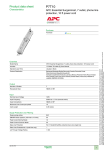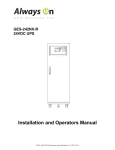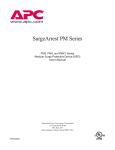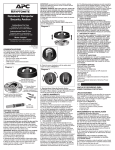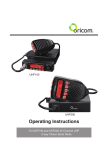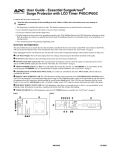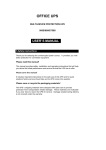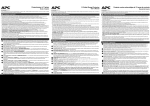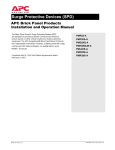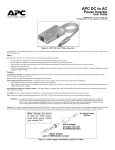Download American Power Conversion PMH3XLM User's Manual
Transcript
R Surge Arrest PM Series ® Model PMH3XLM (For 380/220 Volt Power Systems) Non-Modular Surge Protection Device (SPD) User’s Manual This User Manual is intended for use by qualified personnel only. The Surge Protection Device defined in this manual contains no user-serviceable parts. Installation and maintenance of the Surge Protection Device is to be accomplished by qualified/ licensed electrical personnel only, using the Service Manual for guidance. Installation and maintenance of the Surge Protection Device by non-qualified/licensed electrical personnel will void the warranty. American Power Conversion denies warranty coverage, as well as any liability for a device that has been installed or maintained by non-qualified/licensed personnel. Copyright © 2001 American Power Conversion Corporation 132 Fairgrounds Road P.O. Box 278 West Kingston, Rhode Island 02892 USA 990-0538 6/01 SurgeArrest PM Series ® Contents INTRODUCTION.......................................................................................................................................... 1 WARNINGS, CAUTIONS, and NOTES ..................................................................................................... 1 INSTALLATION and MAINTENANCE CONSIDERATIONS .............................................................. 1 Fastener Installation ........................................................................................................................... 1 Electrical Bonding and Grounding..................................................................................................... 1 Wire Routing ...................................................................................................................................... 1 Electrical Connector Mating .............................................................................................................. 1 Electro-Static Discharge..................................................................................................................... 2 Soldering ............................................................................................................................................ 2 INSTALLATION ........................................................................................................................................... 2 TESTING ........................................................................................................................................................ 2 UNPACKING and PRELIMINARY INSPECTION.................................................................................. 2 Storage................................................................................................................................................ 2 LOCATION CONSIDERATIONS .............................................................................................................. 2 Environment ....................................................................................................................................... 2 Audible Noise..................................................................................................................................... 2 Mounting and Cabinet Data ............................................................................................................... 2 Service Clearance............................................................................................................................... 3 Equipment Performance..................................................................................................................... 3 Product Orientation ............................................................................................................................ 4 System Grounding.............................................................................................................................. 4 ELECTRICAL CONNECTIONS ................................................................................................................ 4 Overcurrent Protection ....................................................................................................................... 4 Voltage Rating.................................................................................................................................... 4 Terminals............................................................................................................................................ 4 Parallel Connection ............................................................................................................................ 5 Wire Size ............................................................................................................................................ 5 PMH3XLM SERIES INSTALLATION INSTRUCTIONS....................................................................... 6 Typical Unit Installation, Three Phase WYE, 4 Wire, plus Ground.................................................. 6 Circuit Breaker and Disconnect Switch ............................................................................................. 8 OPERATION and FEATURES.................................................................................................................... 8 Status Panel Controls, Indicators, and Alarms................................................................................... 9 Audible Alarm and Control................................................................................................................ 9 Dry Contacts..................................................................................................................................... 10 Environmental Monitoring Unit Option........................................................................................... 10 CORRECTIVE MAINTENANCE (Repair) ............................................................................................. 11 Troubleshooting ............................................................................................................................... 11 Display Board Removal and Replacement Instructions................................................................... 12 PREVENTIVE MAINTENANCE - Inspection and Cleaning ................................................................. 12 REPLACEMENT PARTS .......................................................................................................................... 12 LIMITED WARRANTY ............................................................................................................................. 14 TECHNICAL SUPPORT............................................................................................................................ 14 i Contents - continued Tables Table 1 - Voltage Rating and Service Type (by Model) .................................................................... 4 Table 2 - Relay Contact Pin Arrangement ....................................................................................... 10 Figures Figure 1 - SPD Mounting Requirements............................................................................................ 3 Figure 2 - Typical Parallel Connections............................................................................................. 5 Figure 3 - Status Panel with Surge Counter Option ........................................................................... 9 Figure 4 - Troubleshooting Flow Chart............................................................................................ 11 Figure 5 - Display Board Locator Diagram ..................................................................................... 13 ii INTRODUCTION Thank you for choosing the APC SurgeArrest PMH3XLM Series Surge Protection Device (SPD). This User Manual provides important information for the owner of APCs Non-Modular PMH3XLM SurgeArrest SPD. Specific technical information contained in this manual has been provided for planning purposes only. Note: SPDs are also known as Transient Voltage Surge Suppressors (TVSS). The SPD must be installed by qualified/ licensed electrical personnel only, using the Service Manual provided with the device. The installer should follow the steps outlined in the Service Manual to insure proper installation. A copy of the installer’s invoice detailing the installation of this device is required in order to obtain warranty service for the device. The only serviceable component of this device is the Display Board Assembly. This device contains no user-serviceable parts. Please read and understand all information contained in this manual prior to use. This manual is to be used as a guide for using the device. The APC modular Surge Protection Device (SPD) is a high quality, high energy surge attenuation system that has been designed to protect sensitive equipment from damaging transient voltage surges in 380/220 volt power system applications. The PMH3XLM unit is a parallel SPD designed for service entrance and downstream panelboard applications. Proper use is imperative to maximize the surge suppressor’s effectiveness and performance. The PMH3XLM provides surge protection per phase and is available with a 120kA per phase rating. All APC products are extensively tested according to industry standards as set by IEC 60950, and is qualified for all circuit capacities. Note: When planning the placement of this device, consideration should be given to the connection method to be used. In some applications, this device may require several feet of wire. Increased wire lead length adversely affects clamping voltages. WARNINGS, CAUTIONS and NOTES • Warnings statements in this manual provide information, which if not complied with, may result in personnel injury or death. • Cautions statements in this manual provide information, which if not complied with, may result in damage to equipment. • Notes presented in this manual contain information deemed essential to highlight. INSTALLATION CONSIDERATIONS For system deployment planning purposes, during installation into an electrical system, the SPD must NOT be energized until the electrical system is completely installed, inspected, and tested. All conductors must be connected and functional, including the neutral (blue wire). The voltage rating of the device and system must always be verified before energizing the SPD. Failure to follow these guidelines can lead to abnormally high voltage being applied to the SPD. This may cause the SPD to prematurely fail or significantly shorten the effective life. The warranty does not cover an incorrectly installed device. TESTING Also for system deployment planning purposes, any factory or on-site testing that exceeds the normal operating voltage such as high-potential insulation testing, or any other tests where the suppression components will be subjected to voltages higher than their rated "turn on" voltage, must be run with the SPD disconnected from the power source. For 4-wire SPDs, the neutral connection at the SPD must also be disconnected prior to performing high-potential testing, and then reconnected upon completion of the test. Caution: The SPD and its associated suppression components must be disconneted during elevated voltage testing. Failure to comply may result in damage to the suppression components and/or other electronic components. UNPACKING and PRELIMINARY INSPECTION • Inspect the entire shipping container for damage or signs of mishandling before unpacking the unit. • Remove the cardboard packing and further inspect the unit for any obvious shipping damages. • If damage found is a result of shipping or handling, immediately file a claim with the shipping company and forward a copy to APC. Page 1 Storage The unit should be stored in a clean, dry environment. Storage temperature is -40o C (-40o F) to +60o C (+140o F). Avoid exposing the unit to areas of high condensation. All of the packaging materials should be left intact until the unit is ready for installation. If the unit has been stored for an extended period of time, it may be necessary to clean the unit and make a complete inspection of the unit prior to having it installed and placing it into service. LOCATION CONSIDERATIONS Environment The SPD is designed to operate indoors in an ambient temperature range of -40o C (-40o F) to +60o C (+140o F) with a relative humidity of 0% to 95% non-condensing. The standard unit is in a Type 1 industrial use enclosure intended for indoor use. Primarily, it provides a degree of protection against contact with the enclosed equipment. It should not be installed in areas with excessive dust, flammable materials, corrosive vapors or explosive atmospheres. Audible Noise The unit background noise is negligible, and does not restrict the location of the installation. Mounting and Cabinet Data For planning purposes, the PMH3XLM is designed to be wall mounted. The unit size is as shown in Figure 1, and weighs 17 pounds (7.71 kg). Shipping weight is 19 pounds (8.618 kg). 6.0" (15.24 cm) 5.5"D (13.97 cm) * Mounting Holes are 5/16" (7.11 mm) * Unit Weight is 17 lbs. (7.71 kg) 8.0" (20.32 cm) Display Board 8.75" 9.5" (22.22 cm) (24.13 cm) 8.0" (20.32 cm) Figure 1. SPD Mounting Requirements **Surge Protection Devices are designed for use on the load side of the service entrance disconnect only** Service Clearance In addition to national and local code requirements, 36 inches of service clearance is needed at the front of the SPD. Page 2 WARNING • INSTALLATION or MAINTENANCE OF THIS SURGE PROTECTION DEVICE MUST BE PERFORMED BY QUALIFIED PERSONNEL ONLY. • DURING NORMAL OPERATION, HAZARDOUS VOLTAGES ARE PRESENT INSIDE THE UNIT. • WHEN SERVICING THIS UNIT, SERVICE PERSONNEL MUST BE SURE TO FOLLOW ALL ELECTRICAL SAFETY PRECAUTIONS. • ALL POWER SOURCES TO THIS UNIT SHOULD BE LOCKED OFF BEFORE SERVICING. THIS WILL PREVENT THE RISK OF RECEIVING AN ELECTRICAL SHOCK. Equipment Performance For planning purposes, in order to obtain maximum system performance, the SPD must be located as close to the circuit to be protected as possible, minimizing the interconnecting wire length. For every foot of wire length, approximately one (1) nanosecond of turn-on/turn-off time is added, and approximately 175 volts (6kV/3kA, 8/20 microseconds) is added to the clamp voltage. For optimum transient surge protection, staged surge suppression should be implemented at the service entrance and all other electrical connections to the building (telephone, CATV, etc.). It should also be implemented at recognized surge generating loads within the building (arc welding rigs, large motors, switched capacitors, etc.). Additionally, it should be implemented for sensitive electronic loads (computer equipment, facsimile machines, copy machines, solid state motor drives, variable frequency drives, etc.). For interconnected electronic loads (via data cabling), surge protection devices should also be utilized to protect the devices on either end of the interconnecting data cables. APC manufactures a complete line of surge protection devices for both alternating current (AC) and direct current (DC) applications. Contact an authorized APC reseller, or order directly from APC at www.apc.com. Product Orientation To decode the Model Number and determine the unit’s configuration, locate the printed nameplate on the outside of the unit. Note: The Serial Number, Date of Manufacture, and Suppression Voltage Rating (SVR) are also on the unit identification nameplate. The Model Number can be decoded as follows: • • • • PM identifies a SurgeArrest Panel Mount product. The following letter indicates the voltage and wiring configuration of the device. Following this letter is the number 3. This number identifies the surge current ratings to be 120kA per phase. Following the number 3 is the letter X. This indicates that the unit is non-modular. Following the "X" letter designation are the letters LM, which indicates that this model has been designed for use in South America. Options are detailed later in this manual. System Grounding For planning purposes, equipment grounding conductor must be used on all electrical circuits connected to the SPD. This requirement is primarily for safety, although SPD performance is enhanced by proper grounding. Proper operation of any surge suppression system or device depends on a proper grounding system. Incorrect grounding practices will reduce the effectiveness or interfere with SPD system operation and performance, as well as endanger personnel and equipment. For the best performance, use a single point ground system where the service entrance grounding electrode system is connected to and bonded to all other available electrodes, building steel, metal water pipes, driven rods, etc. For sensitive electronics and computer systems, the recommended ground impedance measurement is 25 ohms or less. When a metallic raceway is used as an additional grounding conductor, an insulated grounding conductor should be run inside the raceway. Adequate electrical continuity must be maintained at all raceway connections. Do not use isolating bushings to interrupt a metallic raceway run. A separate isolated ground for the SPD is NOT recommended. Page 3 **On 4-Wire Power Systems, neutral to ground bonding should be installed per national and local electrical codes. Failure to comply may result in damage to the equipment.** ELECTRICAL CONNECTIONS Overcurrent Protection The Surge Protection Device (SPD) draws very little current under normal conditions and will only conduct for a brief duration upon encountering a transient surge voltage. APC SPDs contain internal fusing to protect against abnormal voltage conditions. Note: Fuses are not replaceable. Voltage Rating Prior to having the SPD installed, verify that the unit has the correct voltage rating by checking the nameplate voltage or model number. The service type should match the intended power source. See Table 1 for the voltage rating and service type of the SPD. Table 1: Voltage Rating and Service Type Model Number PMH3XLM Voltage Rating and Service Type 220/380 Volts, 3- Phase, WYE Terminals Terminals have been provided inside the APC non-modular SPD for line (phase), neutral, and equipment safety ground connections. Terminal wire size range for all models is #8 AWG. Installation torque is 65 inch-pounds. ! WARNING VERIFY THAT ALL POWER CIRCUITS ARE DE-ENERGIZED BEFORE MAKING CONNECTIONS All electrical connections should be performed by a qualified/licensed electrician. All wiring must comply with national and applicable local codes. Parallel Connection When making a parallel type of connection (Figure 2), the length of the wiring to the Surge Protection Device (SPD) must be kept as short as possible to substantially enhance the performance. Long wire runs are to be avoided for the unit to perform as intended. To reduce the impedance the wire displays to surge currents, the phase, neutral, and ground conductors are to be routed within the same conduit and should be tightly bundled or twisted together to optimize performance of the unit. Sharp bends in the conductors are to be avoided. Wire Size With a parallel connection, the size of the wiring to the SPD is independent of the ampere rating of the circuit to be protected. The recommended wire size is based on the unit’s transient surge current capabilities. #8 AWG is the recommended wire size for phase, neutral, and ground. **Surge Protection Devices are designed for use on the load side of the service entrance disconnect only** Page 4 To "Protected" Loads Phase A Phase B Phases Neutral Phase C Neutral Bus Neutral (if used) Ground Ground Ground Bus Interconnecting Wiring * Minimize Length * Avoid Sharp Bends Figure 2. Typical Parallel Connections WARNING • MAINTENANCE or INSTALLATION OF THIS SURGE PROTECTIVE DEVICE MUST BE PERFORMED BY QUALIFIED PERSONNEL ONLY. • DURING NORMAL OPERATION, HAZARDOUS VOLTAGES ARE PRESENT INSIDE THE UNIT. • WHEN HAVING THIS UNITSERVICED, ENSURE SERVICE PERSONNEL FOLLOW ALL ELECTRICAL SAFETY PRECAUTIONS (See Service Manual). • ALL POWER SOURCES TO THIS UNIT SHOULD BE LOCKED OFF BEFORE SERVICING. THIS WILL PREVENT THE RISK OF RECEIVING AN ELECTRICAL SHOCK. OPERATION and FEATURES SPD's do not require operator intervention after installation. However, the LEDs should be checked weekly to ensure that the SPD is functional. NOTE: The PMH3XLM has a green LED for each phase which extinguish when the module is no longer providing protection (fault condition). The only serviceable part is the Display Board Assembly (see Service Manual). The PMH3XLM contains a diagnostic circuit which monitors the suppressors status continuously and automatically. If a fault condition were to occur, the built-in front panel audible alarm will sound and a red "Service" LED will light, indicating that the unit is in need of service by a qualified electrician. Page 5 The audible alarm can be silenced by pressing the "Mute Alarm" button on the touchpad, until a qualified electrician or service person is available to service the unit. The red "Service" LED will continue to be illuminated even though the audible alarm has been silenced. This will continue until the fault condition has been cleared. Have the electrician use the Service Manual to locate and repair the fault. Status Panel Controls, Indicators, and Alarms All indicators and controls are located on the front diagnostic panel (Figure 3) of the PMH3XLM unit. Each phase features a tri-color LED indicator. Green indicates correct operation. Amber indicates reduced protection. Red indicates loss of protection. If an inoperative condition were to occur, the built-in audible alarm will sound and the red Service LED will illuminate. This indicates that the unit needs evaluation by a qualified electrician or technician. Until a qualified person evaluates the unit, press the Mute Alarm touchpad to silence the alarm. (The LED indicator above the Mute Alarm touchpad illuminates when the alarm is deactivated. Normal operation occurs with the Mute Alarm LED extinguished.) The red Service LED will remain illuminated even though the Audible Alarm has been silenced. The Test touchpad tests the red Service LED and the Audible Alarm. If LEDs are illuminated in a manner that suggests contradictory information, there may be an internal logic problem and the unit needs replacement. If none of the LEDs are illuminated, the unit may not be installed correctly. Please note that the internal storage capacitor for surge counter backup must be energized for about 15 minutes before the “count” push button will function. If a green LED is not illuminated and is suspect of being faulty, a qualified electrician or technician may attempt to diagnose the problem by de-energizing the unit, removing the front cover and exchanging ribbon cable leads with another phase (if available). Upon reenergizing the PMH3XLM, the appropriate LED will illuminate if the suspect LED has failed. If troubleshooting indicates a failed LED, please contact APC Technical Support at: 800-800-4APC. SurgeArrest® PM R Test: Tests the red Service LED and audible alarm Phase A Phase B Phase C Service Test Reset Reset: Resets the optional surge counter. Mute Alarm: Turns the Alarm off. (Note that the alarm is de-activated when the LED is lit). Phase A, B, and C: Tri-color LED status indicators: Green = Full protection Amber = Partial protection Red = No protection Service: LED illuminates for any amber or red indication. Mute Alarm Figure 3. Status Panel with Surge Counter Option Audible Alarm and Control The PMH3XLM device is equipped with an audile alarm which will sound in the event of an alarm condition. In addition, the red Service LED will illuminate, indicating the device needs service. Press the Mute Alarm touchpad to silence the alarm. The red Service LED will remain on even though the alarm is silenced. The Audible Alarm can be tested by pressing the Test touchpad. This tests the alarm regardless of the Mute Alarm status. The Test touchpad tests the red Service LED and the Audible Alarm. Page 6 Dry Contacts The PMH3XLM includes a set of Dry Contacts available at a terminal block at the right-front of the inside panel. This feature provides two sets of normally open (NO) and normally closed (NC) contacts which can be used for remote monitoring of the PMH3XLM’s operating status by changing state when there is an alarm condition. Examples of remote monitoring equipment include a computer interface board, emergency management system, or APC’s Environmental Monitoring Unit Option (see Environmental Monitoring Unit Option). The relay contact pin arrangement is outlined in Table 2. (Note: The jumpered connections of Pins 7, 8, & 9 do not represent a third set of contacts). For applications using Dry Contacts, please note the following information: • The Dry Contacts are designed for low voltage or control signals only. The maximum switching current is 1 amp. The maximum switching voltage is 24 volts, DC or AC. • Higher energy applications may require additional relay implementation outside the PMH3XLM. Damage to the PMH3XLM unit’s relay caused by implementation with energy levels in excess of those discussed in this manual will not be covered by warranty. Note that the Dry Contacts will allow the PMH3XLM unit to communicate with one (1) external device. Table 2: Relay Contact Pin Arrangement Relay Contact Set 1 Form "C" Relay Contact Set 2 Form "C" Pin Contact Type 1 Normally Closed (1) 2 Common (1) 3 Normally Open (1) 4,7 Normally Closed (2) 5,8 Common (2) 6,9 Normally Open (2) NOTE: Pin pairs 4 & 7, 5 & 8, and 6 & 9, are connected via jumper internally. The combined current of each pin pair may not exceed 1 Ampere. Environmental Monitoring Unit Option APC offers a Environmental Monitoring Unit Option, which allows the user to monitor the alarm status of the connected SPD. The product is available as a 120-volt external power supply (AP9312PM) or as a 100-240 volt universal input external power supply (AP9312PMI). The AP9312PM is connected to the SPD using Dry Contacts. When an alarm is triggered, the Dry Contact closes and the Environmental Monitoring Unit Option sends up to four e-mail messages to preprogrammed addresses, notifying the address that the SPD is in an alarm condition. The e-mail messages can be sent to computers, pagers, cell phones, or Palm® Computers anywhere in the world over the internet. The AP9312PM has its own internet protocol (IP) address and is usually connected to a 10Base/T communications network. It then uses its internal browser software to host a web page on the internet. Facility managers can monitor the status of the Environmental Monitoring Unit using their computer and internet browser, such as Microsoft® Internet Explorer®. An qualified/licensed electrician is required for installation of the Environmental Monitoring Unit Option to the Dry Contacts of the SPD. Page 7 CORRECTIVE MAINTENANCE (Repair) SurgeArrest PMH3XLM units are designed for years of reliable, trouble-free operation. However, even the most reliable equipment can fail. Built-in diagnostics are an integral part of the PMH3XLM and indicate if service is required. Audible alarms and abnormal illumination of LEDs indicate problems within the PMH3XLM, and possibly within the electrical system. Quality SPDs, such as the PMH3XLM, are designed and tested to withstand severe duty. However, various electrical distribution problems exist that a PMH3XLM will not protect against. Should a problem arise, a qualified electrician should first perform an overview of the electrical distribution system, including verification of proper voltages and phasing. Regardless of the cause, PMH3XLMs will sacrifice themselves while attempting to protect their load. Accordingly, a failed PMH3XLM may indicate other problems, as its failure is the effect rather than the cause. Standard troubleshooting procedures should be used to isolate problems. See Figure 4 (Troubleshooting Flowchart) for assistance. Replace bad components with identically rated parts to continue proper operation and safety. Note: The only replaceable component of the PMH3XLM is the Display Board, or the unit itself. Troubleshooting Troubleshooting of an SPD consists of performing the sequence of steps provided in the Troublshooting Flow Chart in Figure 4. Perform the steps in this chart only to the extent necessary to clear the fault. Alarm Audible/Visual Red Service LED Lit? START No Yes Possible Display Board Failure. Call APC Technical Support 1-800-800-4APC END Yes All Front Panel Green LEDs Lit? All Front Panel Green LEDs Lit? Yes No Apparent Problem No No Have Electrician Verify Voltage is Correct on all Phases? No Have Electrician Correct Power Utility Feed and Verify Power Levels and Operation Yes WARNING SECURE ALL POWER (REMOVE POWER) TO THE SPD END Possible Unit Failure. Call APC Technical Support 1-800-800-4APC Figure 4. Troubleshooting Flow Chart Page 8 END PREVENTIVE MAINTENANCE - Inspection and Cleaning Inspection of the SPD should be performed periodically to maintain reliable system performance and continued transient voltage surge protection. While it is difficult to establish a preventive maintenance schedule because conditions vary from location to location, inspections for failed LEDs and other signs of trouble utilizing the built-in diagnostics should be performed on a routine basis (weekly or monthly). REPLACEMENT PARTS The only replaceable item in the SPD is the Display Board Assembly (see Figure 5), and must be replaced by a qualified electrician. Ribbon Cable Connectors Ribbon Cables (to Chassis) Display Board Retaining Hardware (4 places) Display Board Chassis Cover (Chassis not shown) Ground Wire (to Chassis) Not to exact scale. Figure 5. Display Board Locator Diagram Page 9 LIMITED WARRANTY APC warrants it’s AC panel protection products against defects in workmanship and materials for 5 years from the date of original purchase. The panel protection device must be installed by a qualified and licensed electrician in order to qualify for warranty protection. Liability is limited to the replacement of the defective product. A Return Material Authorization must be given by APC prior to the return of any product (see Technical Support and Customer Service). A copy of the invoice from the installer (electrician or electrical service company) must accompany the defective device being returned. If the return of a device is authorized by APC, APC will immediately ship a replacement unit to the customer. Along with the replacement unit, APC will include a pre-paid shipping tag for the return of the originally defective unit. The replacement unit will not be warranteed unless the defective unit is received by APC. Under no circumstance is APC responsible for the cost of removal or installation of any panel protection device. APC also offers unlimited replacement of modular and component parts within the warranty period previously described. APC specifically disclaims all other warranties, expressed or implied. Additionally, APC will not be responsible for incidental or consequential damages resulting from any defect in any product or component thereof. TECHNICAL SUPPORT and CUSTOMER SERVICE United States and Canada: 1-800-800-4APC This manual, as well as information about the entire APC product line is available on the internet at: www.apc.com. Prior to calling APC for technical assistance or ordering parts, please have the following information available: Model Number of unit: ________________________________________________________ Serial Number of unit: ________________________________________________________ Manufacture Date: ________________________________________________________ Purchase Date: ________________________________________________________ Your Order Number: ________________________________________________________ Return Shipment Address American Power Conversion Corporation 1600 Division Road Dock 25 West Warwick, Rhode Island 02893 USA Attn: RMA#_______________________ Page 10













